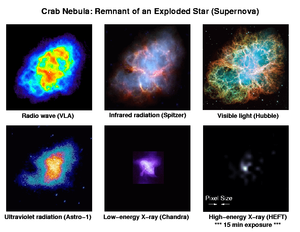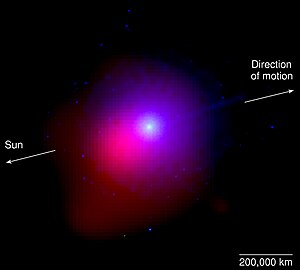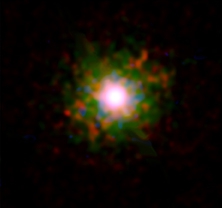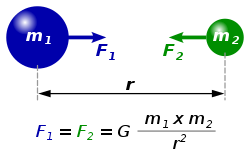Portal:Radiation astronomy

Radiation astronomy is astronomy applied to the various extraterrestrial sources of radiation, especially at night. It is also conducted above the Earth's atmosphere and at locations away from the Earth, by satellites and space probes, as a part of explorational (or exploratory) radiation astronomy.
Seeing the Sun and feeling the warmth of its rays is probably a student's first encounter with an astronomical radiation source. This will happen from a very early age, but a first understanding of the concepts of radiation may occur at a secondary educational level.
Radiation is all around us on top of the Earth's crust, regolith, and soil, where we live. The study of radiation, including radiation astronomy, usually intensifies at the university undergraduate level.
And, generally, radiation becomes hazardous, when a student embarks on graduate study.
Cautionary speculation may be introduced unexpectedly to stimulate the imagination and open a small crack in a few doors that may appear closed at present. As such, this learning resource incorporates some state-of-the-art results from the scholarly literature.
The laboratories of radiation astronomy are limited to the radiation observatories themselves and the computers and other instruments (sometimes off site) used to analyze the results.
Radiation astronomy objects

Def. a hemispherical pit a basinlike opening or mouth about which a cone is often built up any large roughly circular depression or hole is called a crater.
The image at right shows a chain of 13 craters (Enki Catena) on Ganymede measuring 161.3 km in length. "The Enki craters formed across the sharp boundary between areas of bright terrain and dark terrain, delimited by a thin trough running diagonally across the center of this image. The ejecta deposit surrounding the craters appears very bright on the bright terrain. Even though all the craters formed nearly simultaneously, it is difficult to discern any ejecta deposit on the dark terrain.
Stellar surface fusion

Stellar surface fusion occurs above a star's photosphere to a limited extent as found in studies of near coronal cloud activity.
Surface fusion is produced by reactions during or preceding a stellar flare and at much lower levels elsewhere above the photosphere of a star.
"Nuclear interactions of ions accelerated at the surface of flaring stars can produce fresh isotopes in stellar atmospheres."[1]
"This energy [1032 to 1033 ergs] appears in the form of electromagnetic radiation over the entire spectrum from γ-rays to radio burst, in fast electrons and nuclei up to relativistic energies, in the creation of a hot coronal cloud, and in large-scale mass motions including the ejections of material from the Sun."[2]
"The new reaction 208Pb(59Co,n)266Mt was studied using the Berkeley Gas-filled Separator [BGS] at the Lawrence Berkeley National Laboratory [LBNL] 88-Inch Cyclotron."[3]
266Mt has been produced using the 209Bi(58Fe,n)266Mt reaction.[3]
"Reactions with various medium-mass projectiles on nearly spherical, shell-stabilized 208Pb or 209Bi targets have been used in the investigations of transactinide (TAN) elements and their decay properties for many years. These so-called “cold fusion” reactions produce weakly excited (10-15 MeV) [1] compound nuclei (CNs) at bombarding energies at or near the Coulomb barrier that de-excite by the emission of one to two neutrons."[3]
"The laboratory-frame, center-of-target energy used was 291.5 MeV, corresponding to a CN excitation energy of 14.9 MeV."[3]
"At the start of the experiment the BGS magnet settings were chosen to guide products with a magnetic rigidity of 2.143 T·m to the center of the [focal plane detector] FPD. After the first event of 266Mt was detected in strip 45 (near one edge of the FPD), the magnetic field strength was decreased to 2.098 T·m in an effort to shift the distribution of products toward the center of the detector."[3]
"258Db [has been produced] via the 209Bi(50Ti,n) and 208Pb(51V,n) reactions [15], and 262Bh via the 209Bi(54Cr,n) and 208Pb(55Mn,n) reactions [13, 16]."[3]
"Hofmann et al. at Gesellschaft für Schwerionenforschung (GSI) in Darmstadt, Germany, and Morita et al., at the Institute of Physical and Chemical Research (RIKEN) in Saitama, Japan, have studied the 209Bi(64Ni,n)272Rg reaction [7, 17, 18]. The complementary 208Pb(65Cu,n)272Rg reaction was studied by Folden et al. at the Lawrence Berkeley National Laboratory (LBNL) [19]."[3]
"Based on the observation of the long-lived isotopes of roentgenium, 261Rg and 265Rg (Z = 111, t1/2 ≥ 108 y) in natural Au, an experiment was performed to enrich Rg in 99.999% Au. 16 mg of Au were heated in vacuum for two weeks at a temperature of 1127°C (63°C above the melting point of Au). The content of 197Au and 261Rg in the residue was studied with high resolution inductively coupled plasma-sector field mass spectrometry (ICP-SFMS). The residue of Au was 3 × 10−6 of its original quantity. The recovery of Rg was a few percent. The abundance of Rg compared to Au in the enriched solution was about 2 × 10−6, which is a three to four orders of magnitude enrichment."[4]References
- ↑ Vincent Tatischeff, J.-P. Thibaud, I. Ribas (January 2008). "Nucleosynthesis in stellar flares". eprint arXiv:0801.1777. http://arxiv.org/pdf/0801.1777. Retrieved 2012-11-09.
- ↑ R. P. Lin and H. S. Hudson (September-October 1976). "Non-thermal processes in large solar flares". Solar Physics 50 (10): 153-78. doi:10.1007/BF00206199. http://adsabs.harvard.edu/full/1976SoPh...50..153L. Retrieved 2013-07-07.
- ↑ 3.0 3.1 3.2 3.3 3.4 3.5 3.6 S. L. Nelson, K. E. Gregorich, I. Dragojević, J. Dvořák, P. A. Ellison, M. A. Garcia, J. M. Gates, L. Stavsetra, M. N. Ali, and H. Nitsche (February 25, 2009). "Comparison of complementary reactions in the production of Mt". Physical Review C 79 (2): e027605. doi:10.1103/PhysRevC.79.027605. http://prc.aps.org/abstract/PRC/v79/i2/e027605. Retrieved 2014-04-07.
- ↑ A. Marinov, A. Pape, D. Kolb, L. Halicz, I. Segal, N. Tepliakov and R. Brandt (2011). "Enrichment of the Superheavy Element Roentgenium (Rg) in Natural Au". International Journal of Modern Physics E 20 (11): 2391-2401. doi:10.1142/S0218301311020393. http://www.phys.huji.ac.il/~marinov/publications/Rg_261_arXiv_77.pdf. Retrieved 2014-04-08.
Continua

Lyc photon or Ly continuum photon or Lyman continuum photon are a kind of photon emitted from stars. Hydrogen is ionized by absorption of Lyc photons. Lyc photons are in the ultraviolet portion of the electromagnetic spectrum of the hydrogen atom and immediately next to the limit of the Lyman series of the spectrum with wavelengths that are shorter than 91.1267 nanometres and with energy above 13.6 eV.

Solar X-ray astronomy is a branch of X-ray astronomy which focuses on understanding the origin of X-ray emission from the Sun. Most of our current knowledge of the Sun comes from observing it in the visual portion of the electromagnetic spectrum. However, when observed with appropriate instruments in the X-radiation portion of this spectrum the Sun is almost a variable star, and at times almost a dark star.
GOES 14 was launched into orbit on June 27, 2009 at 22:51 GMT from Space Launch Complex 37B at the Cape Canaveral Air Force Station. GOES 14 is a more recent satellite to be launched with X-ray detection capability currently in operation. The importance of X-ray astronomy is exemplified in the use of an X-ray imager such as the one on GOES 14 for the early detection of solar flares, CMEs and other X-ray generating phenomena that impact the Earth.

Comet Lulin was passing through the constellation Libra when the Swift Gamma-Ray Burst Mission imaged it on January 28, 2009. This image merges data acquired by Swift's Ultraviolet/Optical Telescope (blue and green) and X-Ray Telescope (red). At the time of the observation, the comet was 99.5 million miles from Earth and 115.3 million miles from the Sun. Credit: .
First infrared source in Crux

The first infrared source in Crux is unknown.
The field of infrared astronomy is the result of observations and theories about infrared, or infrared-ray sources detected in the sky above.
The first astronomical infrared source discovered may have been the Sun.
But, infrared rays from the Sun are intermingled with other colors so that the Sun may appear yellow-white rather than infrared.
The early use of sounding rockets and balloons to carry infrared, optical, or visual detectors high enough may have detected infrared-rays from the Sun as early as the 1940s.
This is a lesson in map reading, coordinate matching, and searching. It is also a project in the history of infrared astronomy looking for the first astronomical infrared source discovered in the constellation of Crux.
Nearly all the background you need to participate and learn by doing you've probably already been introduced to at a secondary level and perhaps even a primary education level.
Some of the material and information is at the college or university level, and as you progress in finding infrared sources, you'll run into concepts and experimental tests that are an actual search.
Radiation detector astronomy quiz

Radiation astronomy detectors is a lecture as part of the radiation astronomy department course on the principles of radiation astronomy.
You are free to take this quiz based on radiation astronomy detectors at any time.
To improve your score, read and study the lecture, the links contained within, listed under See also, External links, and in the {{principles of radiation astronomy}} template. This should give you adequate background to get 100 %.
As a "learning by doing" resource, this quiz helps you to assess your knowledge and understanding of the information, and it is a quiz you may take over and over as a learning resource to improve your knowledge, understanding, test-taking skills, and your score.
Suggestion: Have the lecture available in a separate window.
To master the information and use only your memory while taking the quiz, try rewriting the information from more familiar points of view, or be creative with association.
This quiz may need up to an hour to take and is equivalent to an hourly.
Enjoy learning by doing!
Astronomical analysis laboratory

This laboratory is an activity for you to analyze an astronomical situation. While it is part of the astronomy course principles of radiation astronomy, it is also independent.
Astronomical analysis is the detailed examination of the elements or structure of some astronomical thing (an entity, source, or object), typically as a basis for discussion or interpretation.
Once an astronomical situation has been selected, it must be separated into its constituent elements, for example, the identification and measurement of the chemical constituents of a substance or specimen.
You may choose an astronomical situation to dissect.
I will provide one example of this process. Please put any questions you may have, and your laboratory results, you'd like evaluated, on the laboratory's discussion page.
Enjoy learning by doing!
Energy phantoms

Students start from specific situations of motion, determine how to calculate energy and convert units, then evaluate types of energy.
Def. a quantity that denotes the ability to do work and is measured in a unit dimensioned in mass × distance²/time² (ML²/T²) or the equivalent is called energy.
Def. a physical quantity that denotes ability to push, pull, twist or accelerate a body which is measured in a unit dimensioned in mass × distance/time² (ML/T²): SI: newton (N); CGS: dyne (dyn) is called force.
In astronomy we estimate distances and times when and where possible to obtain forces and energy.
The key values to determine in both force and energy are (L/T²) and (L²/T²). Force (F) x distance (L) = energy (E), L/T² x L = L²/T². Force and energy are related to distance and time using proportionality constants.
Every point mass attracts every single other point mass by a force pointing along the line intersecting both points. The force is proportional to the product of the two masses and inversely proportional to the square of the distance between them:[1] - ,
where:
- F is the force between the masses,
- G is the gravitational constant,
- m1 is the first mass,
- m2 is the second mass, and
- r is the distance between the centers of the masses.

The diagram shows two masses attracting one another. Credit: Dna-Dennis.
In the International System of Units (SI) units, F is measured in newtons (N), m1 and m2 in kilograms (kg), r in meters (m), and the constant G is approximately equal to 6.674×10−11
N m2 kg−2.[2]
Observationally, we may not know the origin of the force.
Coulomb's law states that the electrostatic force experienced by a charge, at position , in the vicinity of another charge, at position , in vacuum is equal to:
where is the electric constant and is the distance between the two charges.
Coulomb's constant is
where the constant is called the permittivity of free space in SI units of C2 m−2 N−1.
For reality, is the relative (dimensionless) permittivity of the substance in which the charges may exist.
The energy for this system is
where is the displacement.
References
- ↑ - Proposition 75, Theorem 35: p.956 - I.Bernard Cohen and Anne Whitman, translators: Isaac Newton, The Principia: Mathematical Principles of Natural Philosophy. Preceded by A Guide to Newton's Principia, by I. Bernard Cohen. University of California Press 1999 ISBN 0-520-08816-6 ISBN 0-520-08817-4
- ↑ CODATA2006. http://www.physics.nist.gov/cgi-bin/cuu/Value?bg.
Fields associated with radiation astronomy include Astronomy, Astrogeology, Astrognosy, Astrohistory, Astrophysics, Atmospheric sciences, Charge ontology, Chemistry, Cosmogony, Fringe sciences, Geochemistry, Geochronology, Geology, Geomorphology, Geophysics, Geoseismology, Hydromorphology, Lofting technology, Mathematics, Measurements, Mining geology, Nuclear physics, Oceanography, Petrophysics, Radiation physics, Shielding, Spaceflights, Structural geology, Technology, Trigonometric-parallax astronomy, and X-ray trigonometric parallax
Other Wikiversity science-related portals: Anthropology - Archaeology - Astronomy - Biology - Biochemistry - Chemistry - Ecology - Fluid mechanics - Genetics - Hematology - Immunology - Life sciences - Materials science and engineering - Neurology - Organic chemistry - Particle physics - Quantum biology - Regional anatomy - Sciences - Technology
|
Wikiversity's sister projects
Wikiversity is hosted by the Wikimedia Foundation, a non-profit organization that also hosts a range of other multilingual and free-content projects: Wikipedia
Free-content encyclopedia Wikibooks
Free textbooks and manuals Commons
Shared media repository Incubator
Wikimedia incubator Wiktionary
Dictionary and thesaurus Wikiquote
Collection of quotations Wikinews
Free-content news Betawikiversity
Betawikiversity project Wikispecies
Directory of species Wikisource
Free-content library Wikivoyage
Open travel guide Phabricator
MediaWiki bug tracker Meta-Wiki
Wikimedia project coordination MediaWiki
Free software development Wikidata
Free knowledge base Wikimedia Labs
MediaWiki development Wikiversity is also available in other languages: |
Content by Subject
Arts ·
Humanities ·
Mathematics ·
Medicine ·
Science ·
Social Sciences ·
Technology
Content by Level
Pre-school Education ·
Primary Education ·
Secondary Education ·
Tertiary Education ·
Non-formal Education ·
Research































